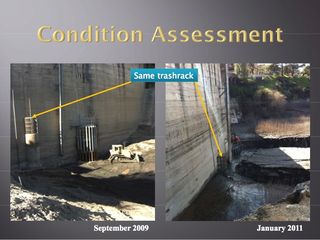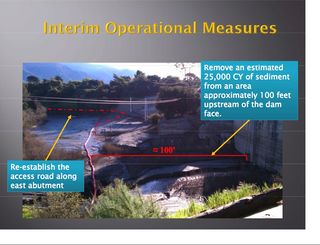Even though the county has stalled the startup of sediment removal from Hahamongna Watershed Park, the department of public works is going ahead on an interim plan to clear the area of the park nearest Devil's Gate Dam.
 According to Christopher Stone, Assistant Deputy Director of the county Dept. of Public Works, the county wants to remove 25,000 cubic yards of sediment from the south end of the watershed before the next storm season.
According to Christopher Stone, Assistant Deputy Director of the county Dept. of Public Works, the county wants to remove 25,000 cubic yards of sediment from the south end of the watershed before the next storm season.
Pictured: from the presentation, the side of Devils Gate Dam,
before and after sediment washed down from the 2009 Station Fire.
Stone gave a presentation to the Altadena Town Council at its Tuesday night meeting about the interim plan for Hahamongna Watershed sediment cleanup. The county board of supervisors recently halted a fast-track plan to remove sediment from the Hahamongna Watershed after objections from the public about the removal of trees and habitat such a cleanup would entail, as well as the thousands of truck trips it would take to move the vast amount of sediment that has built up over the decades and after the Station Fire.
But while the county supervisors's request for an environmental impact report has halted immediate action, some interim form of mitigation needs to be done to clear up the area, which was filled with additional thousands of square yards of sediment following the fire and significant rainfall. The watershed is a key line of defense against potential flooding in Pasadena, South Pasadena, and other communities downstream along the Arroyo Seco.
Stone said that the interim plan would still involve removing 2,500 truckloads of sediment from the southern end of the watershed, where there is little vegetation. Right now, the plan is for trucks to travel along Oak Grove Dr. to Berkshire and on the freeway. The sediment would be dumped in the Scholl Canyon Landfill near Glendale.
In response to a question from councilman Phil Barela, Stone said that they do not plan to run the trucks during the drop off and pickup times at nearby La Canada High School.
 The first step in the interim plan would be restoring the access road to the outside, followed by removing the sediment. The plan would not start until the area dries significantly, Stone said -- although they emptied the reservoir last week, discharging the flow into the Arroyo Seco, the ground is still too wet to work on.
The first step in the interim plan would be restoring the access road to the outside, followed by removing the sediment. The plan would not start until the area dries significantly, Stone said -- although they emptied the reservoir last week, discharging the flow into the Arroyo Seco, the ground is still too wet to work on.
The interim plan also involves modifying the drainage areas, including higher and finer-grain "trashracks" that block solid matter from entering the dam spillways.
Stone said there would also be public hearings announced before the interim plan begins to sound out public comment, including which surface streets would be actually used by the trucks.
Pictured: the interim plan involves removing 25,000 cubic yards
of sediment from the Devil's Gate Dam to an area 100 feet upstream.



